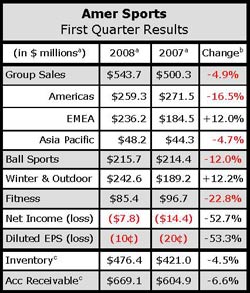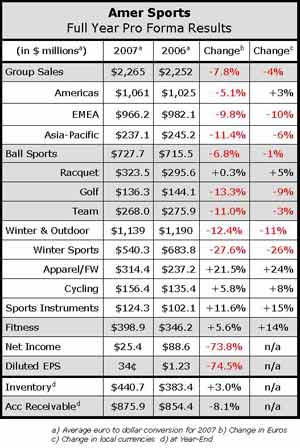Amer Sports had another difficult quarter in Q1  as sales declined in the mid-singles due to weakness at Precor and Wilson and a slumping U.S. dollar hurt results for the Finland-based company. The company did however manage to shrink its quarterly loss by over 50%, mainly through synergies in Winter Sports Equipment manufacturing. Overall, the company reported a 4.9% decline in first quarter net sales to 363.0 million ($543.7 mm). Excluding the effect of foreign currency translation, net sales would have grown 2% for the quarter.
as sales declined in the mid-singles due to weakness at Precor and Wilson and a slumping U.S. dollar hurt results for the Finland-based company. The company did however manage to shrink its quarterly loss by over 50%, mainly through synergies in Winter Sports Equipment manufacturing. Overall, the company reported a 4.9% decline in first quarter net sales to 363.0 million ($543.7 mm). Excluding the effect of foreign currency translation, net sales would have grown 2% for the quarter.
Fueled by the increased Winter & Outdoor sales, Amer saw its greatest sales growth in the EMEA region, but weakness in the Americas and Asia Pacific. On a geographic basis, sales in EMEA increased 12%, but declined by 16% in the Americas and by 5% in Asia Pacific. In local currency terms, net sales were up 13% in EMEA, but down 6% in the Americas and 1% in Asia Pacific.
The Group's EBIT amounted to 0.0 million after a loss of 7.8 million last year. The Winter and Outdoor business also contributed to the EBIT improvement simply through the strong sales growth line.
Net sales for the Winter and Outdoor segment increased 12.2% to 162.0 million ($242.6 mm) from 144.4 million ($189.2 mm) for the year-ago first quarter, but grew 15% when measured in local currencies. Sales were buoyed by an easy comp in Winter Sports Equipment as well as new product launches in Apparel and Footwear, but were slowed by the effects of currency translation.
Winter Sports Equipment sales jumped 17.7% to 37.3 million ($55.9 mm) for the first quarter from 31.7 million ($41.5 mm) last year and grew 22% excluding the effects of currency conversion. However, compared to the first quarter of 2006 when the market last had a strong winter, sales declined 34.7%. Sales of both Atomic and Salomon hardgoods were fueled by increased demand for alpine skiing equipment, especially in Central Europe. The cross-country skiing equipment market was described as still extremely challenging with management pointing to the Nordic countries in particular as being difficult in a dry winter.
Management focused on the restructuring initiatives it began at the start of the calendar year as a means of boosting the bottom line for Winter Sports Equipment, even during a soft winter. The companys new plan involves different sites specializing in different areas of the process with the changes estimated to reduce headcount by approximately 400 during 2008. Labor negotiations with employees were said to be currently underway, with completion anticipated to occur during the second quarter. Annual cost savings are expected to amount to 20 million, starting in 2009.
Apparel and Footwear sales increased 16.7% for the quarter, or 18% in local currencies, to 70.6 million ($105.7 mm) from 60.5 million ($79.3 mm) last year as the company continues to focus on the opportunities in Salomon softgoods. Amer specifically pointed to the successful launch of Wings running shoes as pushing sales. Cycling sales, mainly attributed to the Mavic brand, grew 10.9% to 33.5 million from 30.2 million and grew 13% currency-adjusted. Sports Instrument sales decreased 3.7% to 20.6 million ($30.9 mm), but grew 1% in local currency terms. Amer management commented that they felt the sales decline was a result of planned introductions later this year making retailers wait to place orders.
With softness in the Nordic countries, the Winter & Outdoor segment saw the strongest sales growth come from the Asia Pacific region.
Still, all regions posted increased sales over the first quarter of 2007. On a geographic basis, sales for the Winter and Outdoor business were up 35% in Asia Pacific, 13% in EMEA, and 10% in the Americas when measured in local currencies.
Earnings before interest and taxes improved to a loss of 14.6 million ($21.9 mm) from a loss of 34.4 million ($45.1 mm) last year for the Winter & Outdoor segment. The improvement was due to strong growth in the profitability of Apparel and Footwear and an increase in Winter Sports Equipment sales over the previous year.
Though the Winter & Outdoor business finally turned positive this quarter, Amer continues to struggle in trying to figure out the Wilson business, which is now called the companys Ball Sports division. Division sales decreased 12.0% for the quarter to 144.0 million ($215.7 mm) from 163.6 million ($214.4 mm), due largely to weak Golf sales through planned reductions. In local currency terms, sales decreased 4% for the first quarter.
Racquet Sports net sales declined 3.8% to 62.6 million ($93.8 mm) from 65.1 million ($85.3 mm) last year, but rose 3% in currency-neutral terms. Amer said that accessories and strings were the fastest-growing businesses for the quarter.
Team Sports sales dropped 13.0% to 58.0 million ($86.9 mm) from 66.7 million ($87.4 mm) for the first quarter, but declined 2% in local currency terms. Management said the business had a strong quarter at specialty stores, but that growth was more than offset by a very soft big box business.
Golf net sales declined 26.4% to 23.4 million ($35.0 mm) from 31.8 million ($41.7 mm) last year and decreased 21% in local currency terms. Wilson Golf's sales were cut by the companys decision made in 2007 to license the golf business in Japan and to close down golf ball production in the United States. In addition to this, the company cited the softening of the economy and increased share of private labels as causing decreased sales to department stores in the United States for the Wilson brand. Management noted that though the brand experienced soft results in the U.S. during the quarter, the business “developed favorably” in Europe.
Sales were up in EMEA, but down in all other regions with Japan especially taking a hit as that business shifted to a licensed model. In local currency terms, sales increased 8% in EMEA, but declined 5% in the Americas and dropped 21% in Asia.
EBIT declined 20.7% to 15.7 million ($23.5 mm) from 19.8 million ($25.9 mm) last year, declining 12% in local currency terms.
Amers Fitness division, or Precor, saw net sales slide 22.8% to 57.0 million ($85.4 mm) from 73.8 million ($96.7 mm) last year with currency-neutral sales declining 13%. The company said that sales to health clubs “continued to thrive” in both North America and EMEA, but softening consumer demand in the U.S. had a noticeable impact.
In local currency terms, sales were up 29% in EMEA, and down 10% in Asia Pacific and 19% in the Americas.
Due to the considerable fall in sales, EBIT decreased 62.6% to 3.7 million ($5.5 mm) from 9.9 million ($13.0 mm) last year.
>>>Amer needs another good winter to keep things rolling, but it looks like the Private Brands phenomenon may be having an adverse effect on Wilson…









